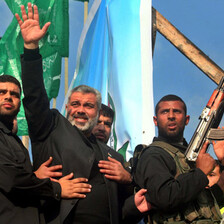The Electronic Intifada 1 August 2003
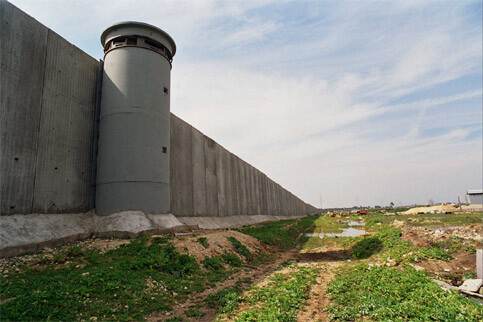
The Wall around Qalqiliya. A twenty-five foot high concrete cage cuts residents off from their agricultural land, necessary for their survival, and prevents you from traveling even 5 minutes out of the City. A single gate, open at the whims of the occupying army, controls 100,000 residents.
Israel’s Separation Barrier, dubbed the “Apartheid Wall” or “Berlin Wall” by Palestinians, has increasingly attracted international media attention, largely due to the hard-to-ignore scale of the project.
The most obvious historical parallel to the barrier is the Berlin Wall, which was 96 miles long (155 kilometers). Israel’s barrier, still under construction, is expected to reach at least 403 miles in length (650 kilometers). The average height of the Berlin Wall was 11.8 feet (3.6 metres), compared with the maximum* current height of Israel’s Wall — 25 feet (8 metres).
[*it is not clear whether the shorter fence sections, about 6 meters in height, are first or final stages in Israel’s construction of the barrier.]
Israel’s barrier is therefore planned to be four times as long and in places twice as high as the Berlin Wall.
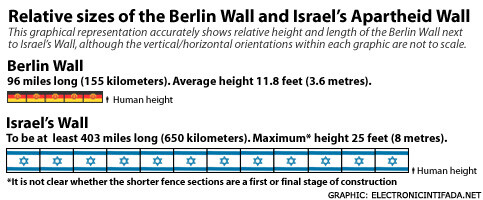
Photographs of the barrier available on the wire services show two main types of section — a wall made of concrete or concrete/fence combination, and a fence-only version of the barrier. Some references in the media suggest that the two main forms of the barrier correspond to differing levels of implementation of security by Israel, with the wall sections reserved for areas perceived as “especially vulnerable”, the fence sections for areas less so. (Source: Text of multimedia element on website of The Guardian).
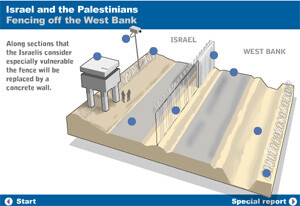
At this point in time it is not known exactly what proportions of the length of the barrier is fence versus wall, or if the fence is merely a temporary state until a wall can be built in all areas but — nonetheless — the wall unquestionably represents a considerable portion of the visible manifestation of the barrier.
WIRE SERVICE IMAGES OF THE SEPARATION BARRIER
Wire service images are important at they represent part of the education of foreign and photo editors sitting in newsrooms around the world who have not actually seen the barrier with their own eyes. With caption descriptions of the barrier ranging from “concrete wall” to the wonderfully inventive “concrete fence” of AFP’s Yoav Lemmer, a large number of images from the wire services make it absolutely clear that the barrier is not merely or entirely a “fence”.
The original AFP caption attached to the bottom right image includes some editorialising, claiming the barrier was built to “stop Palestinian terrorists from entering Israel”, with no mention of what effect it has on the farmers and residents of Qalqiliya.
As you read the captions, and look at the photos, it’s hard to ignore what is in front of your eyes. This structure is clearly no “fence”.
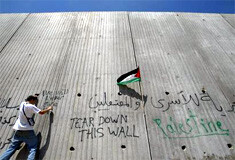
Original caption: A foreign activist from the International Solidarity Movement organization sprays graffitti to the cement-blocks wall erected by Israel, during a demonstration against the wall, in the northern West Bank town of Qalqilya Thursday July 31, 2003. Protesters splashed the separation barrier with balloons filled with green, black, red and white paint — the colors of the Palestinian flag — and hoisted a banner calling the fence, which Israel says was built for its security, an apartheid wall. (AP Photo/Lefteris Pitarakis)
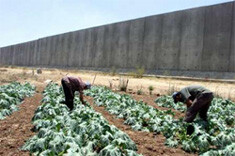
Original caption: Palestinian farmers tend to their aubergine crop in the shadow of a concrete wall erected across their land by the Israeli army to stop Palestinian militants slipping into Israel from the West Bank city of Qalqilya July 7, 2003. Palestinians fear the barrier, consisting of walls and electronic fences now stretching around 150 kms (90 miles), will dash their dream of a viable state in the West Bank, the goal of a new U.S.-backed peace plan. (Reuters/Mahfouz Abu Turk)
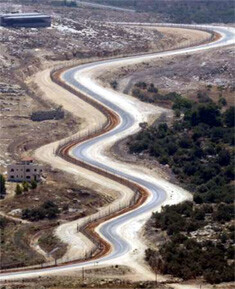
Original caption: An aerial view shows the construction site of the security fence which will seperate Israel from the West Bank, near the West Bank city of Tulkarm, July 30, 2003. Israeli Prime Minister Ariel Sharon has told U.S. President George W. Bush that Israel will keep building a West Bank security fence despite U.S. concerns the barrier could block Middle East peacemaking. (REUTERS/Reinhard Krause)
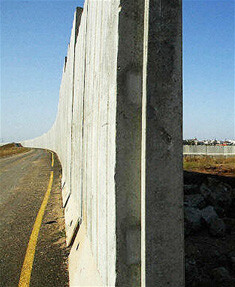
Original caption: The concrete fence erected by Israel alongside the West Bank town of Qalqiliya to stop Palestinian terrorists from entering Israel. The Israeli defence ministry announced the completion of the first section of the barrier. (AFP/File/Yoav Lemmer)
SEMANTIC PROBLEMS RELATING TO THE STRUCTURE OF THE BARRIER
Typically, Israeli terminology is favored in US reportage of the Israeli-Palestinian conflict. In Hebrew, the word for fence is gader. Consequently, the preferred Israeli terminology for the barrier is gader hafradeh (“separation fence”).
The Hebrew words for wall are qir and chomah. The former is mostly used for structures and buildings; the latter for protective fortifications — the formulation chosen by Israeli activist organisation Gush Shalom. Either of them would be more appropriate for this particular structure.
The semantic problems posed by the use of the word “fence”, in either language, are enormous:
fence (n.)1. A structure serving as an enclosure, a barrier, or a boundary, usually made of posts or stakes joined together by boards, wire, or rails.
wall (n.)
1. An upright structure of masonry, wood, plaster, or other building material serving to enclose, divide, or protect an area, especially a vertical construction forming an inner partition or exterior siding of a building.
2. A continuous structure of masonry or other material forming a rampart and built for defensive purposes. Often used in the plural.
4. (a) Something resembling a wall in appearance, function, or construction.
Source: American Heritage English Dictionary (irrelevant definitions deleted)
To characterise the structure as a “fence” without referencing its other features is highly misleading.
The route of the wall
Similarly, looking at the route of Israel’s Wall, it is clear that the wall does not run along the Green Line that separates Israel proper from the West Bank but rather runs through the West Bank, on Palestinian land.

A Palestinian-compiled map of the Israeli barrier plans from the Palestinian Hydrology Group and the Land Research Center. EI altered the legend text for greater clarity.
ABBAS’, BUSH’S AND SHARON’S WORD CHOICES WHEN CHARACTERISING THE SEPARATION BARRIER
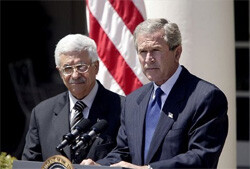
Above: President George W. Bush and Palestinian Prime Minister Mahmoud Abbas hold a joint press conference in the Rose Garden Friday, July 25, 2003. “To break through old hatreds and barriers to peace, the Middle East needs leaders of vision and courage and a determination to serve the interest of their people. Mr. Abbas is the first Palestinian Prime Minister, and he is proving to be such a leader,” said President Bush. (White House/Paul Morse)
“cannot be realized if Israel continues to grab Palestinian land. If the settlement activities in Palestinian land and construction of the so-called separation wall on confiscated Palestinian land continue, we might soon find ourselves at a situation where the foundation of peace, a free Palestine state, living side-by-side in peace and security in Israel is a factual impossibility. Nothing less than a full settlement freeze will do because nothing less than a full settlement freeze will work. For the sake of peace, and for the sake of future Palestinian and Israeli generations, all settlement activities must be stopped now, and the wall must come down.” (Source: White House Transcript)

Above: President George W. Bush and Israeli Prime Minister Ariel Sharon laugh together during their joint press conference in the Rose Garden Tuesday, July 29, 2003. (White House/Paul Morse)
Bush: During his earlier meeting with Abbas, Bush commented on the barrier, saying:
“I think the wall is a problem, and I discussed this with Ariel Sharon. It is very difficult to develop confidence between the Palestinians and the Israel — Israel — with a wall snaking through the West Bank.”
Bush additionally characterised the barrier twice during the meeting with Abbas as a “fence”, the sole word he used when Sharon was present.
Following Sharon’s speech, during the media question time, an Israeli journalist present challenged President Bush on his earlier use of the word “wall”, asking:
“Mr. President, what do you expect Israel to do in practical terms in regarding the separation fence that you call the wall? Due to the fact that this is one of the most effective measure against terrorism, can you clarify what do you oppose — the concept of the separation fence, or only its roots?”
Bush’s answer displayed far less resolve on the matter than during the meeting with Palestinian Prime Minister Abbas just four days previously:
“Look, the fence is a sensitive issue, I understand. And the Prime Minister made it very clear to me that it was a sensitive issue. And my promise to him is we’ll continue to discuss and to dialogue how best to make sure that the fence sends the right signal that not only is security important, but the ability for the Palestinians to live a normal life is important, as well.”(Source: White House Transcript)
Nonetheless, politicking aside, Bush did acknowledge during the course of the two meetings that he recognised that part of the structure was a “wall” even if he only used this word interchangably with ‘fence’ when the Israelis were not around. He also acknowledged that its path was “snaking through the West Bank,” which maps of the wall depict unambiguously.
MEDIA REPORTAGE OF THE SEPARATION BARRIER
With the US President acknowledging both the physical structure and path of the Separation Barrier and the photographs and maps of the Wall available on the wire services available to the US media, one would be tempted to imagine that journalists would notice a few obvious facts.
First, that the Separation Barrier is very possibly a wall under construction — with some areas having both fence and wall, and other areas still with just a fence (perhaps the first stage of a wall). And second, that its path does not run along the Green Line between the West Bank (which the internatonal community considers to be occupied Palestinian territory) and Israel — but actually inside the West Bank, on Palestinian land.
The barrier ranges from 30 to 150 meters wide in places, a considerable loss of land. According to Palestinian environmental umbrella organisation PENGON, as of April 2003, “some 14,680 dunums of land have been razed for the footprint of the Wall, including the uprooting of over 102,000 trees.” When completed, 95,000 Palestinians or 4.5% of West Bank population will be isolated and 200,000 Palestinians in East Jerusalem will be totally isolated from the rest of the West Bank. A joint Israeli government/Settlers Council (YESHA) proposal to modify the route of the Wall will isolate another 110,000 Palestinians to reach a total of 400,000 isolated, including those in East Jerusalem, on the Israeli side of the Wall or within a completely isolated section.
Needless to say, as regular readers of The Electronic Intifada’s Coverage Trends section will be painfully aware, the US media seems unable to recognise basic realities that fuel and perpetuate the conflict, thus leaving the citizens that these newspapers, magazines, and electronic media purport to inform in the dark.
The day of Bush’s speech during Abbas’ visit, The Washington Post website published an article ( “Bush Criticizes Israeli Fence”, July 25th), which noted: “President Bush criticized Israel’s efforts to build a fence separating Palestinians and Israelis on the West Bank yesterday, saying it is ‘a problem’ that makes it ‘very difficult to develop confidence between the Palestinians and Israel’ ”, choosing to emphasise Bush’s use of the word “fence” rather than “wall”.
While noting at least that the barrier included both fence and wall components, the Post’s preferred choice of word is apparent when the frequency of appearance is noted:
“The decision by the Bush administration to press the fence issue appears to have taken the Israeli government by surprise. The fence, which is a high concrete wall in some areas and an electronic wire fence elsewhere, has emerged as a key concern for Palestinians, who contend that Israel is using the fence to draw the contours of Palestinian state that would be limited to 45 percent of the West Bank territory. But the fence is not formally mentioned in the U.S.-backed peace plan known as the road map, which is supposed to guide negotiations.”
CNN has had some problems as well over the entirety of the last year, with multiple reports on the website referring to the barrier only as a “fence” and various claims that the barrier runs between the West Bank and Israel:
“Israel’s government insists the fence — which will stretch along the border between Israel and the West Bank — is meant only to provide security, not to form a border.”(Source: “Israel building fence along West Bank”, CNN.com,18 June 2002)
“Israelis say the huge fence system being built along their border with the West Bank will give them more security. Palestinians say the construction of the barrier system will take some of their land.”
(Source: “Opposing views of West Bank fence”, CNN.com, 3 July 2003)
Following effective intervention by at least one correspondent, the text of recent articles on CNN’s website was updated to reflect the realities and hi-tech nature of the structure, although CNN’s graphic of the barrier remains deeply flawed, including the delineation “ISRAEL” appearing over the occupied West Bank:
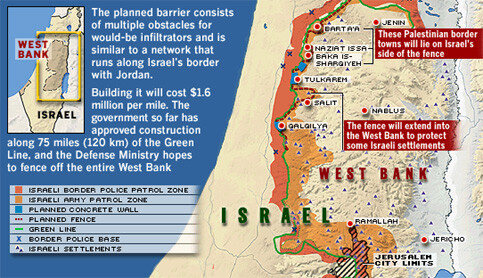
In a 19 July 2003 article with an Associated Press byline, “Penn State student arrested at Palestinian protest back in U.S.”, the article managed to both mischaracterise the barrier as a fence, and its route as on the Green Line:
A part-time Penn State University student arrested while protesting the construction of a security fence between Israel and Palestinian territories is back in the United States, officials said.”
Reuters was less confused, careful to both attribute the source of the terminology to the sides using them in the conflict and the location of the wall:
“Israel pushed ahead Wednesday with construction of a security barrier in the West Bank despite Palestinian dismay and Secretary of State Colin Powell’s pledge to keep pressing on the issue. President Bush failed in talks Tuesday to persuade Israeli Prime Minister Ariel Sharon to stop building what Israel says is a security fence and Palestinians call a new “Berlin Wall.”
And noting it’s makeup:
“But continued construction of the security barrier — a concrete wall in some place and a metal fence topped with razor wire in others — stoked resentment among ordinary Palestinians.”(Source: “Israel Builds Security Barrier Despite Outcry”, Reuters, 30 July 2003).
In this Israeli-Palestinian conflict version of “Is it a bird? Is it a plane? No, it’s Superman!” multi-perspective confusion — as the issue flies across our screens before we can grasp hold of what exactly it is — we are once again cautioned to pay close attention to the language used by the media compared with the actual realities described. Journalism has the potential, like teargas, to blind and disperse while the horrors of history elude us.
As Israel fails to learn the lessons that normal people in East and West Berlin ultimately taught the world on 9 November 1989, we should pay attention to these same people in Palestine, currently living in an increasingly caged environment, watching their land daily swallowed up as Israel rushes to put new facts on the ground while we struggle to keep in focus the fast pace of history — and the even faster pace of Israel’s confiscation of Palestinian land.
Related Links
Nigel Parry is a co-founder of The Electronic Intifada. Co-founders Ali Abunimah and Arjan El Fassed, together with Partners for Peace Executive Director Michael Brown, also contributed to this report.

Israeli ‘shoot to kill’-style warning sign on part of the separation barrier. As expected, the Hebrew word for the barrier is gader (“fence”). However, the Arabic word used is jidar, which — while related at its root to the Hebrew word gader actually means “wall” in Arabic. (ISM)
